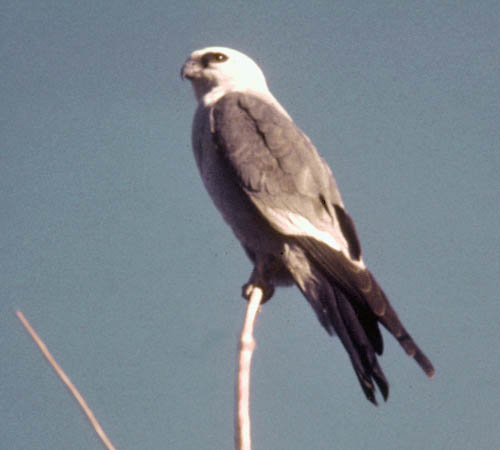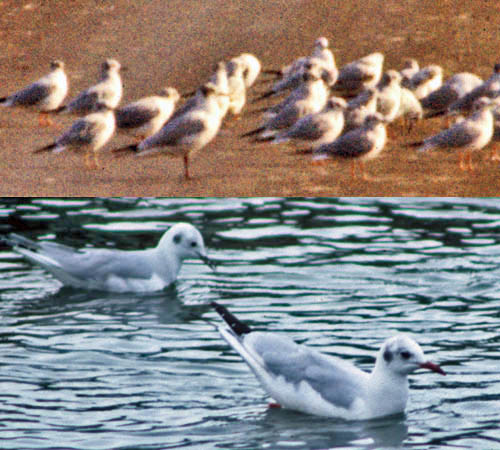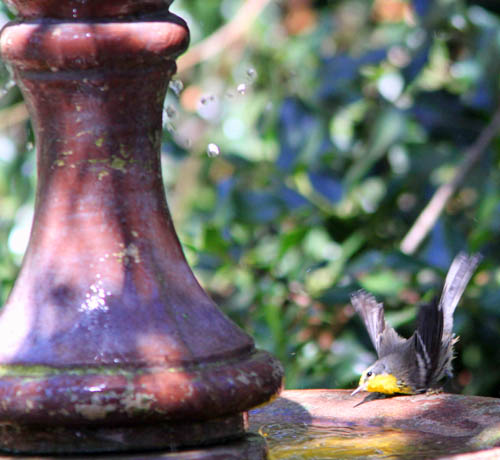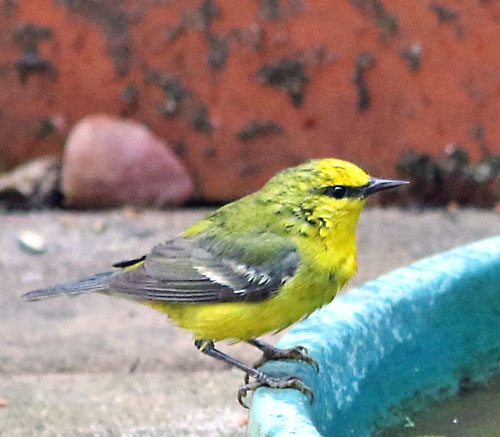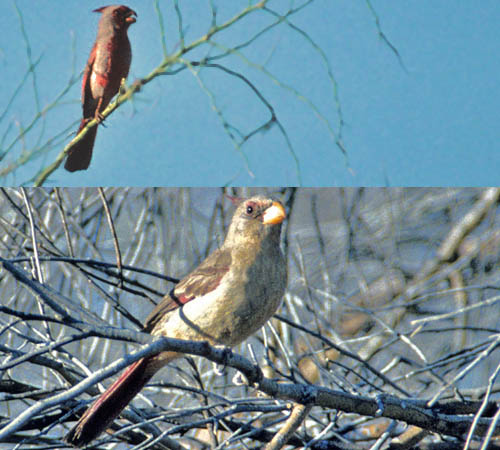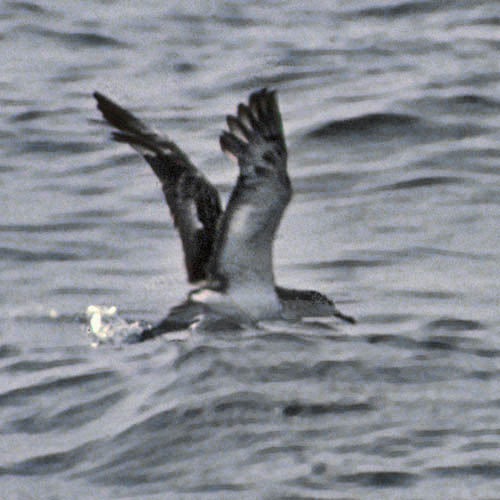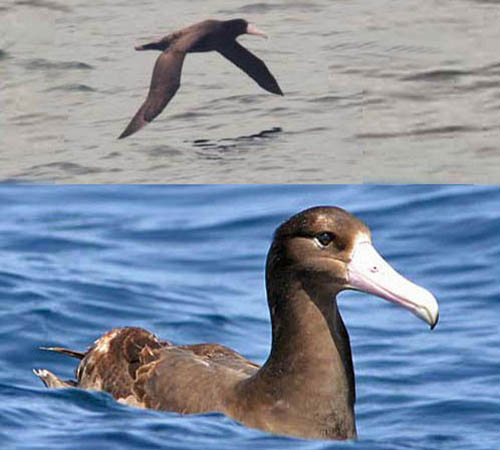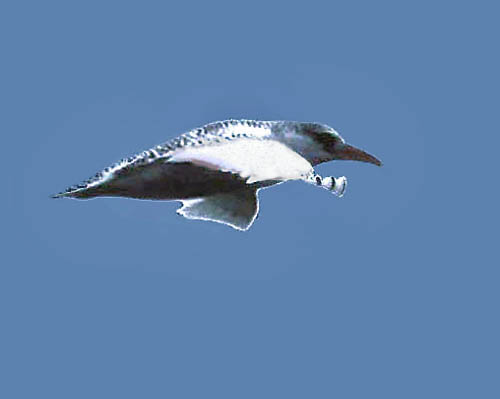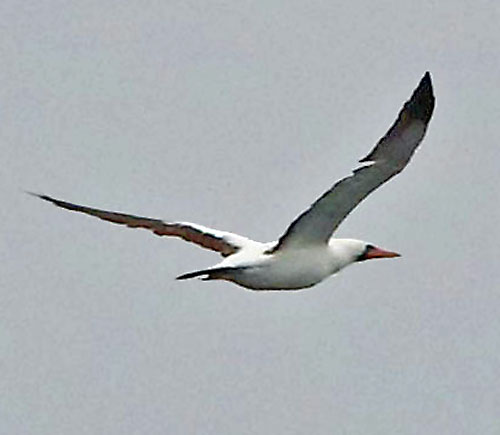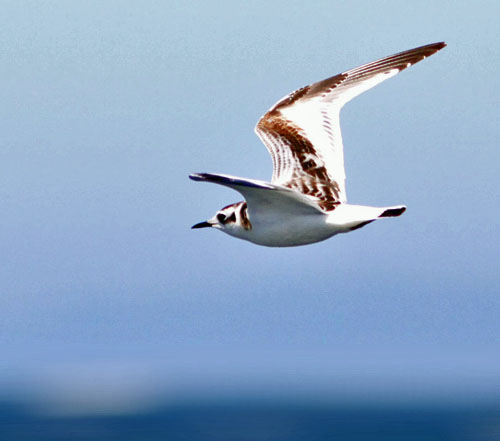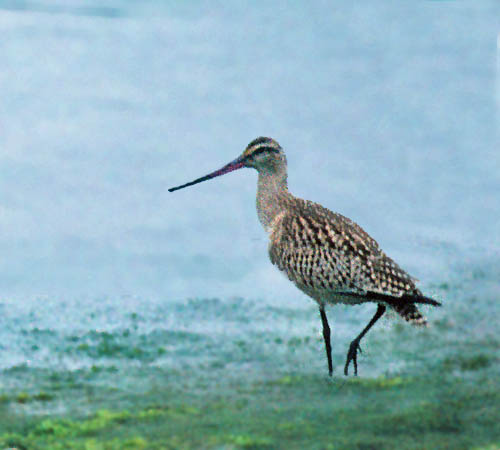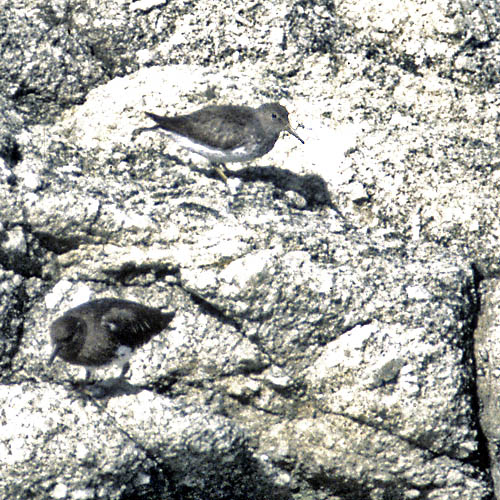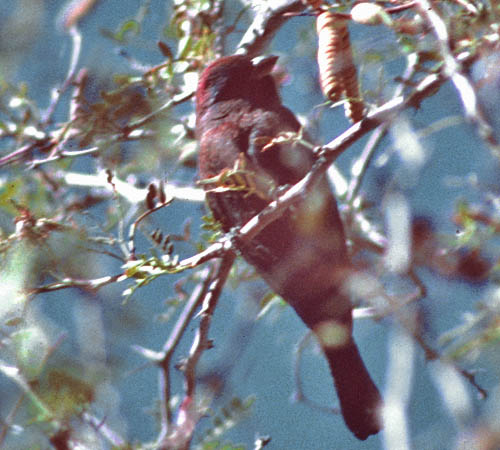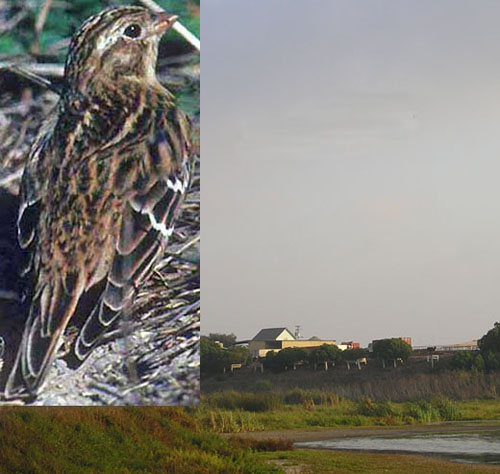| |
When
I fell into the clutches of the hardcore California birding world, I
learned that chasing rarities — an essential element of the subculture
— could be incredibly exhilarating or exceedingly depressing. The
highest pinnacle, however, was to discover, correctly identify, and
spread the word of your "own find." Finding rarities, getting them
right, documenting them, and getting others to see them were the means
to establish one's reputation, for better or worse. Misidentifying a
rarity, poorly documented it with field notes (or not documenting it at
all!), or failing to quickly get out the word to others — these were
(and remain) negatives. The time that I began chasing California
vagrant birds was a great time to do so — the tumultuous 1970s, when
there were still lots of migrant birds, there were still many 'vagrant
trap' locations to be discovered, and there was an unmatched
camaraderie among the participants.
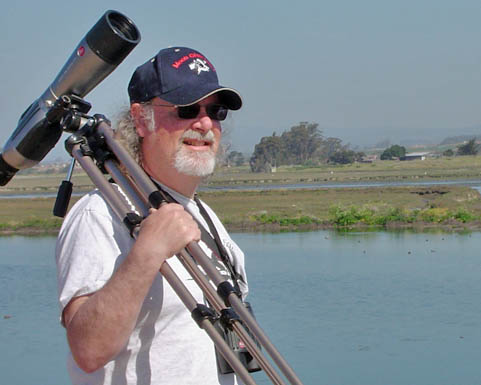 Things
are different now. With the perspective of 40 years, there are many
things I miss about those times, and one of those is just how many
birds there were around [there are also many other things I don't
miss]. Before I begin to forget, I thought it would be fun to put
together a self-ranked "top ten" set of stories and documentation of my
"personal best finds." Things
are different now. With the perspective of 40 years, there are many
things I miss about those times, and one of those is just how many
birds there were around [there are also many other things I don't
miss]. Before I begin to forget, I thought it would be fun to put
together a self-ranked "top ten" set of stories and documentation of my
"personal best finds."
Half of the picks for "best
finds" are from the 1970s. Not only does it feel like there were more
birds then, but I birded all of California much more actively when I
was in college and law school. I did "serious" state Big Years in 1975
and 1977; the latter published in my first book Birders' California
(1978). Now my birding tends to be restricted to Monterey County, where
I have a job, a house, a wife and a cat. Three of the "top ten" picks
are from Monterey County, where I have lived since 1979 (photo left
shows my Moonglow Dairy hat at Moonglow Dairy © Rita
Carratello).Now, the local birding community is much larger and much
more active. And where we once communicated by phone trees, pay phones
or the BirdBox, word of vagrants now typically arrives via cell phones,
texts, or eBird alerts.
In presenting each of my
"top ten" choices below — and a few more — I've added visuals. When
there are photos, I have posted them here. Before 2005, all my photos
were on slide film, except for some efforts at digiscoping in 2004. The
old slides have been digitized below. In the 1970s, however, I didn't
take photos, so I documented my rarities with full written descriptions
of both the bird and the surrounding circumstances. For these I've
created a few collages that combine a photo of the site with pictures
of the species in question (or my quick field sketch), but the art or
photo of birds in these collages do not document the specific 'find' discussed. Occasionally I've used a photo taken by another birder (with permission). |
| |
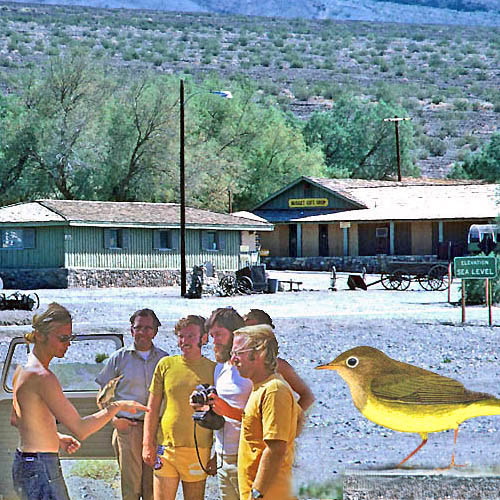 # 1 # 1
Connecticut Warbler on 22 Sep 1974 at Stovepipe Wells, INY
At
a road sign that reads "sea level" in the most barren stretch of Death
Valley is a gas station, general store, and motel called Stovepipe
Wells (right). There are a few scrubby tamarisks but a stop here — even
in migration — rarely exceeds a list of 10 species. And yet the most
unexpected birds appear here. I was here here on 1 June 1974 when the
gas station attendant told us a "bird from Australia" that was out back
— it proved to be an exhausted Least Bittern standing in the desert,
pointing its bill to the sky (thus "Australian" and no, I don't know
why). Van Remsen picked it up to release at a better spot, and in this
collage you can see the bittern sitting on his arm, with Guy McCaskie,
Jon Dun, John Luther, and Steve Summers looking on [Lee Jones hidden
behind].
By 22 Sep 1974, I'd
been exposed to hardcore California birding for barely a year. Yet, at
22 years old, I was already an addict — more interested in searching
for vagrant birds in California than doing anything else. Death Valley
was more than 8 hour away from my Berkeley apartment but I drove there
multiple times a year. On this particular trip in Sep 1974 I was with
Steve Bailey, Joe Morlan, and Charlie Turner. It was very hot when we
stopped at Stovepipe Wells. I looked out back, where the Least Bittern
had been in June, and discovered a Connecticut Warbler
walking on a cement sidewalk. To quote from my notes: It "spent 95% of
time walking on ground, occasionally hopping briefly to lower branches
of tamarisks. It searched the edge of the building ... [and] walked
within 10 feet of me, appeared tame, disoriented, and confused. I
observed it leisurely .... [Later, when I'd found my companions], it
was refound a half-hour later across the road [by the motel] at some
dripping water." I wrote full field notes on the spot — including
details of the brownish hood, yellow belly and long undertail coverts,
complete eye-right, and dusky-flesh colored legs. All of us were just
overwhelmed to see a bird this unexpected, this rare, at this place.
I
think that this still has to be my best personal find in California. It
was the 10th State record [CBRC accepted #1974-079] but the first one
away from the coast [six of the first 10 were caught and banded on the
Farallones, the other three in coastal San Diego Co.]. By the time of
the CBRC's publication of Rare Birds of California (2007)
there were 103 State records but only 7 from the interior. Because of
its secrecy, "Connecticut Warblers are notoriously difficult to find"
in California, says that book. I have never been so lucky again. It
remains the only Connecticut Warbler that I've ever seen in the State.
[the collage combines my 1979 shot of Stovepipe Wells, the June 1974 Least Bittern event there,
and
Thomas Schultz's painting of a Connecticut Warbler from Dunn & Garret (1997) Field Guide to Warblers]
|
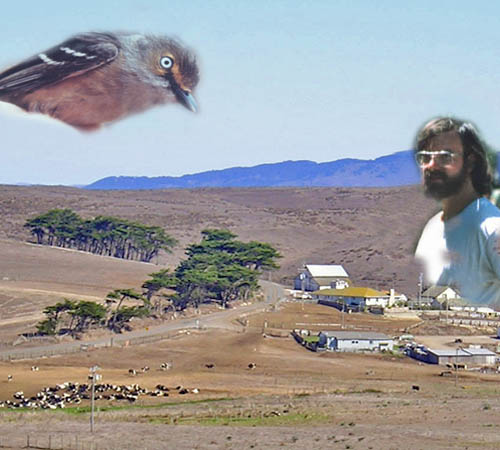 # 2 # 2
White-eyed Vireo on 7 June 1977 at Pt. Reyes NS, MRN
In
1977 I was living in Alameda while going to law school. The nearest
major "vagrant traps" were patches of isolated cypresses on outer Pt.
Reyes, many of them serving as wind-breaks on ranches. This one (photo
at left) is what was then called Mendoza Ranch, with its planted row of
Monterey cypresses. On 7 June 1977, I was chasing a Brown Thrasher seen
the day before by Joe Morlan elsewhere on Pt. Reyes, and that I needed
for a year bird. I stopped at Mendoza at 10:30 a.m. and ran into Bob
Richmond. Suddenly from the canopy of a wind-bent cypress came an
explosive song that I described in my notes as
"chick-a-cheedle-eedle-chick!" with emphasis on first and last note. We
didn't know what it was but the song came every minute of so. Suddenly
the little songster popped out and I said "[expletive deleted], it's a White-eyed Vireo!" I mention that because I almost never swear so the adrenalin rush was very intense. I wrote this in my book Birders' California
(1978) about the 1997 year list: "Those of you who are into very rare
birds will understand the adrenalin, the unsteady hands, the frantic
rush to the nearest phone. The rest think that we're crazy anyway.
However, it was a relief when the first Bay Area birders reached Pt.
Reyes two hours later and I could quit following the bird and let
others view it."
This was California's
second record. The first had been netted on SE Farallon I. on 4 June
1969, 8 years and 3 days before. Henry Robert photographed the Farallon
White-eyed Vireo in-hand, and some of that photo is pasted into this
collage [a picture of me from 1977 is also pasted here]. Van Remsen,
Joe Morlan, the Luthers, and more arrived that first day. I was there
at 8:30 the next morning and, fortunately, so was the singing vireo. It
was a State bird for everyone — even Guy McCaskie who had driven up
from San Diego — the Godfather of California birding and the State's
top field ornithologist.
Thankfully this was a singing adult male and
not an i.d. challenge. The bird was very active and in those days of
film cameras, no one got photos. I wrote full details [CBRC accepted
1977-065]. It stayed two days: 7-8 June 1977. Since then, however, over
50 others have occurred, and there have been years (1992) when a dozen
records were accepted. Still, finding a second State record and a new
species for everyone's list was truly exciting.
[the collage has my photo of Mendoza Ranch with Henry Robert's June 1969 photo of the Farallon bird
[not 'my bird'] overlain above, and Brad Schram's photo of me from back then]
|
# 3
Mottled Petrel seen 12 Dec 1984 from Pt. Pinos MTY
On
this very windy day — the news later said the gusting westerlies were
up to 40 mph — I went to the Point on my lunch hour because it was so
windy. I often scoped while sitting inside my car. The winds were so
strong that the car was shaking too much at the Point, so I went to a
sheltered spot behind a huge boulder a couple turn-outs to the east,
which today we call "Petrel Pt." Looking north with the sun behind me,
there were great views of Pink-foots, Black-vents, and Fulmars, many of
which were being pushed back while trying to fly west past the vantage
point, providing excellent close range views.
After
a half-hour, a procellarid soared up at kelp line, judged as between a
Black-vent and Fulmar in size, showing me its underparts ["clean white
throat & breast, a sharply demarcated and extensive charcoal belly,
sharply cut off from white undertail coverts, and gleaming white
underwings with a broad black ulnar bar across the inner half of the
underwing," to quote my notes]. I knew immediately it was a Mottled
Petrel, and saw both sides well. "I do not know how long this was in
real life — time seemed to stand still — but I did have time to talk to
myself and remind myself to look at the tail and look at the head
pattern and recheck the undertail tails coverts," to quote again. When
it passed to the west, I drew a sketch of what I'd seen on an envelope,
long before books were checked (the quick sketch is inset in this
collage).
[the collage has my photo of heavy seas at Pt. Pinos, my sketch,
and artwork from Peter Harrison's Seabirds book]
|
|
|
# 4
Yellow-bellied Flycatcher on 21 Sep 2004 at Pt. Pinos MTY
As I was completing my loop around Crespi Pond at Pt. Pinos before work this date, I found an Empidonax
flycatcher that looked 'tiny,' short-tailed, short-billed, with a big
round eyering, on a bird that was green above and very bright yellow
below. It had black wings ... [and] white wingbars and tertial edgings
[that] contrasted strongly," to quote notes [full details on-line]. It gave a call I did not recognize: a sharp spweek!
It was already after 9 a.m. and I needed to get to work. So I tried a
few digiscope pics (one of them at left) and posted to local BirdBox. I
and others spent another 1.5 hour with it after work that day, but it
was not there the next morning. It took a couple days to confirm i.d.
from the literature, expert review, and comparison to on-line calls
(see link above).
This was the first record of Yellow-bellied Flycatcher
for MTY; the 18th for California. It is probably the most
"difficult-to-identify" rarity I've found, so that is nice, but more
personally it was a big "catch-up" bird for me. Every other State
lister birding in 1989 had seen one at Galileo Hill, Kern Co. That
Yellow-belly stayed for 5 days [almost all other have been "one day
wonders"]. I was at sea on a NOAA cruise in fall 1989. When I returned
I use to say that "I'd have to find my own" to catch up on this rarity.
It is quite amazing for that to actually happen.
[digiscoped photo 21 Sep 2004 © D. Roberson]
|
# 5
Mississippi Kite on 25 May 1976 at Furnace Creek, INY
By
the middle of the 1970s, the (mostly) college-aged hardcore birders
actively worked a route for vagrants from Oasis in Mono Co. to Death
Valley in Inyo Co. for a week or more around Memorial Day weekend,
camping at one of the ends of this route every day. For me, 25 May was
day 5 of 11 days in 1976. It was tiring business in the heat. We'd
slightly altered the stops on 25 May (to visit Indian Wells) and
arrived at Furnace Creek Ranch in the heat of late afternoon. I took a
nap under a palm tree on the golf course. At 6:30 p.m., I awoke, and
still groggy, "flushed an adult Mississippi Kite from
a row of tamarisks" lining the golf course (to quote my notes). "Upon
flushing, it flew over the date palms and then proceeded to
acrobatically catch dragonflies with its feet and devour them in
mid-air."
I went running to find others
(Paul Lehman, Jon Dunn, Van Remsen et al.) and we refound it 15 minutes
later. It was even still present the next morning, when many others
also saw it; Van Remsen got this photo (right). This was only the 6th
California record but 3 prior ones had also been at Furnace Creek.
During the 30 years thereafter, 7 more were found there. Still, it
remains a major rarity in the State. It took no talent to find — just
being at the right spot at the right time was all that was required...
oh, and yes, being awake.
[photo from 26 May 1976 © J. Van Remsen]
|
|
|
# 6
Black-headed Gull on 20 Mar 1979 at Stockton WTP, S.J. (top left)
and
same Black-headed Gull at same spot on 25 Oct 1982 (lower left)
The
"Patagonia Rest Stop effect" occurs when an influx of birders chasing a
rare bird at a site results in the discovery of more rare birds there,
with the end result being that the locality becomes known for rare
birds, even though in itself it may be little or no better than other
similar sites. The extra rarities found when chasing an earlier rarity
produce this effect. This is one of those examples.
In the morning of 20 Mar 1979, Dick Erickson
found a Little Gull with a flock of 200 Bonaparte's Gulls at the
Stockton wastewater ponds. It was the 9th State record. I chased it
that afternoon. While driving down the main dike, I stopped at the
first flock of Bonaparte's and noted the larger, longer-legged gull
that was beginning to had a hood (see photo top left). The was an adult
Black-headed Gull in spring molt — and a 7th State record. [I also
refound the Little Gull.] This particular Black-headed Gull would
return for 8 consecutive winters [my photo of it in its 5th winter is
bottom left]. Up to 4 Little Gulls also returned here for 11 straight
winters!
Since "my" Black-headed Gull
returned for 8 years and stayed months at a time between Oct–April, it
was seen by hundreds, maybe thousands of birders. Certainly more folks
saw "my" Black-headed Gull than any other bird I've ever found.
[both photos © D. Roberson]
|
# 7
Grace's Warbler on 6 Sep 2014 in Pacific Grove, MTY
In
1979 I moved to Pacific Grove because it was my favorite birding spot
in California. I bought a house in 1983 in a pine forest within walking
distance of Pt. Pinos. Years later my friend Van Remsen visited and
said we needed a fountain; ergo, in spring 2005, the "Van Remsen
memorial fountain and birdbath" was installed. It has a circulating
pump and bubbler, and the water attracts migrant passerines.
I'd been out birding with Rita and friends on 6
Sep 2014 but went home early to watch end of Giants' game [they would
beat Tigers 5-4; the Giants would win their 3rd World Championship in 5
years later that autumn]. In bottom of 8th inning this male Grace's Warbler
appeared at the birdbath. All my plans changed. I took photos of bird,
called Rita (she was at the Frog Pond) and while talking to her a
vagrant American Redstart flew in; then emailed all the local birders.
Eventually more than a dozen observers arrived. The Redstart reappeared
for a late afternoon bath but the Grace's was only found again in
mid-afternoon by a lucky handful in the neighbor's yard [sadly, Rita
never saw it... she does, however, have several 'yard birds' on me,
including a Black-throated Green Warbler].
This was only the second Grace's Warbler for
MTY (one wintered at Jacks Peak from Dec 1998–Feb 1999), and just the
4th in northern California.
[photo 6 Sep 2014 © D. Roberson]
|
|
|
#8
two different Blue-winged Warbler
singing male on 9 June 2001 at Big Sur R. mouth MTY
[no photo]
and
adult on 24 & 26 May 2017 in my Pacific Grove MTY birdbath [left]
In
an initial draft of this page, I left out this species from the "top
10" because I had not been carrying my camera when I found a singing
male Blue-winged Warbler in Andrew Molera SP [sketch
& details accepted by CBRC]. Yet, from my first year as a hardcore
California birders in 1973, I have yearned to see four eastern warblers
for their rarity and beauty: Cerulean, Prothonotary, Golden-winged and
Blue-winged. I've since seen them all in the State, and have had the
pleasure of personally discovering at least one of each except for
Golden-winged. But only in 2017 did I manage to get a photo of a
personally-found example. And even that almost didn't happen.
On Wednesday, 24 May 2017, at 2:45 p.m., I
turned on the fountain to see what would come in. Within 5 minutes the Blue-winged Warbler
flew in for a quite view. I ran to the car to get my camera but it was
gone by the time I got back, and neither I nor the many locals who
showed up to chase could find it the rest of that day. Two days later,
at 6:33 p.m. on Friday, Rita noticed it had re-appeared. We took photos
for 5 minutes while it bathed, and then it was gone. Again, no luck for
those chasing it. But at least there are now images.
[photo 26 May 2017 © D. Roberson]
|
# 9
male Pyrrhuloxia on 18 July 1974 at Westmorland IMP [no photo]
and
3 males + female 29 May 1995 at Chemehuevi Wash SBE [these photos]
The really exciting Pyrrhuloxia
for me was a singing male that I found near Westmorland on 18 July
1974. I'd only just met the wider birding community during the Death
Valley route over Memorial Day weekend in 1974, so nobody outside the
Bay Area knew my name. I was using a Lane Guide to try to find a Crissal Thrasher for a lifer when I spotted the male Pyrrhuloxia sitting on a power line. This was the first rarity I wrote up for Guy McCaskie; he published it in Audubon Field Notes
and told me to send to the CBRC, which I did [accepted #1974-070]. It
proved to be 5th State record, and the first major rarity that I had
personally discovered.
Twenty-one years
later, Rita Carratello and I heard about a male in eastern SBE. I think
we must have been in Death Valley because we chased it for her State
list. There we ran into Bruce Barrett. Not only did we find a singing
male (top right) but two more males and a female (lower right). We
watched the female carrying nesting materials, documented breeding
behavior. The was just the second nesting effort for the State, so was
exciting in its own way.
[both photos 29 May 1995 © D. Roberson]
|
|
|
# 10
pair of Trumpeter Swan on 30 Nov 1991 at Lower Klamath NWR, SIS
It
can be very cold in northeastern California at Thanksgiving. Rita and I
were there in 1991, chasing a Whooper Swan found a week earlier by Ray
Ekstrom. So were many others. We spent all day on 29 Nov seeing lots of
swans but no Whooper. At breakfast in Dorris the next morning, locals
told us of a back road to Whites Lake; after unsuccessful searches
elsewhere, Rita and I tried it at 10 a.m. On the ice at this spot,
close to the Oregon border, were about 20 swans. One drew my attention
by its size. We studied it with a scope, noting bill details that
looked good for Trumpeter Swan, as was the case with
the swan next to it. These two swans then began synchronous
head-bobbing and vocalizing with deep guttural horn-like honks,
becoming more frenzied and vigorous. I passed to the scope to Rita and
got my camera. Suddenly Rita said "Whoa, Nelly! Here's one with lots of
yellow" — an adjacent swan had awoken and Rita had rediscovered the
Whooper! I hardly knew what to do: look at the Whooper? photograph the
Whooper? photo the Trumpeters? The latter took off together, loudly
honking, leaving the Whooper and the Tundra swans behind. And there
were birders to be alerted to these discoveries! We looked left and
were shocked to see other birders watching the same swans, but we still
had to dash off to find others (including Guy McCaskie). All were able
to see the Whooper.
The pair of Trumpeters,
though, were new discoveries. They were accepted by CBRC as the state's
30th record. Since then re-introduced Trumpeters in Oregon have
'muddied' the California situation but finding our own wild Trumpeters
was a fine and enduring memory.
[photo 30 Nov 1991 © D. Roberson]
|
... and from pelagic trips .... |
Pelagic
trips offshore are usually packed with many birders, and it is often
impossible to determine who "found" a pelagic rarity when many birds
are seen by many observers at the same time. On Monterey Bay, it was
often the boat's skipper, the late Richard Ternullo, who spotted the
rarities first. I guess one could pick out who first put a name to the
bird but, even then, when observers are looking from the bow, and the
stern, and the sides, and perhaps an upper deck, multiple observers
might be shouting about the bird without them hearing each other.
Absent some sharp-eyed expert like Steve Howell or Todd Easterla
picking out a Hawaiian Petrel on the horizon, most pelagic species are
group efforts. This is particularly true when sorting out the
identification of an unexpected species takes some time. Here are those
that I feel I had a part in the discovery and/or identification: |
Streaked Shearwater
on 9 Oct 1977 on Monterey Bay MTY
Monterey
Bay was famed for pelagic birds back to the late 1800s. I came on many
boat trips in the 1970s before moving here in 1979. This was one of the
best trips. In the autumn storm-petrel flock we refound the stake-out
Wedge-rumped Storm-Petrel. Then, as related in our published paper
[Roberson et al. 1977] about "6-7 miles west of Moss Landing and above
the south rim of the Monterey submarine canyon," we flushed this
white-faced shearwater off the sea, but it "landed on the water several
times and cautious approach allowed several diagnostic photographs to
be obtained." The article relates that Joe Morlan and I were the first
to suggest it was a Streaked Shearwater, but really
the skipper and all the leaders "found" it at the same time. So I was a
"co-finder" of this vagrant from the western Pacific.
It was just the second record for North
America. Victor Morejohn collected this first on Monterey Bay on 3 Oct
1975, just two years before. Because of that, Joe and I had studied
Streaked Shearwater and were prepared when this one was encountered. As
of this writing (2017) there are 18 California records, but a dozen are
from Monterey Bay. Although I've been on hundreds of Monterey Bay
pelagic trips since 1977, I've not yet encountered another one.
[photo 9 Oct 1977 © D. Roberson]
|
|
|
Short-tailed Albatross on 15 Jan 2000 at San Lucia Bank, SLO (top left)
and, years later,
another young one on 22 Apr 2007 Monterey Bay MTY (lower left)
Short-tailed Albatross is one of only three albatross in the North
Pacific. It almost went extinct in the 20th century. As a huge, very
impressive, and endangered seabird, it has long been on my list of the
"50 best birds" on earth since I first compiled that concept in the
1970s. Obviously, to "personally find" a Short-tailed Albatross would be quite wonderful.
I've been fortunate to see 4 Short-tailed
Albatross so far. The first was during a "chase boat" on 5 Nov 1985 out
of Bodega Bay to the Cordell Bank where one had been the day before. It
was just about the roughest pelagic trip I've done — most of us got
sick — but it was a successful chase!
On 15 Jan 2000, I was co-leader of a Morro Bay
Bird Festival boat trip from Port San Luis with Tom Edell and Curtis
Marantz. I was often on the top deck in the back while the other
leaders were in the front. We had exactly 3 albatross that day: 1
Black-footed, 1 Laysan, and 1 juv Short-tailed (top left). I had the
good fortune to "find" all three albatrosses as they each came up the
wake, but the acoustics were so bad that my shouting only alerted those
at the back. Tom and Curtis likely spotted them passing the bow without
hearing me.
I did not have my camera on the SLO boat, so it
was great to take close photos of another Short-tailed on Monterey Bay
in April 2007 (lower left).
[top left 15 Jan 2000 © Norward Hazard; bottom left 22 Ap 2007 © D. Roberson]
|
juv Red-tailed Tropicbird
on 19 Aug 1992 about 87 nmi wsw of Pt. Piedras Blancas SLO
Between 1989–1992, skipper Richard (Dick) Spight offered his private motor yacht Blitzen
for several ornithological expeditions far offshore the California
coast. The 52-foot sailboat could take 6 birders and a crew of 3. I was
very lucky to be invited to sail from San Diego to San Francisco Bay in
August 1992. We had a full boat from San Diego to Santa Barbara, but
during the next leg that left Santa Barbara on 18 Aug, the only bird
observers were Steve Bailey, Dick Erickson and me. 1t was a moderate,
overcast, Beaufort 4 day on 19 Aug. At 9:20 a.m. Dick and I spotted a
tropicbird sitting on the sea ahead of us at the same time. It took off
as we approached, circled us for photos, and proved to be juv Red-tailed Tropicbird — only the 8th for California. Water temps were warm: 63.4°F [=17.4°C]. We also had 7 Cook's Petrels this day.
Red-tailed Tropicbird is now thought to be a
semi-regular part of the avifauna in the warmer North Pacific gyre this
far offshore, beyond the influence of the cold California current, but
still very few birders in this State have seen one.
[photo 19 Aug 1992 © D. Roberson] |
|
|
adult Nazca Booby
on 16 July 2016 in Monterey Bay MTY
For
most of 2016 a significant El Niño event dominated the flora and
fauna of Monterey Bay. Sea surface temperatures were unusually warm.
Several Brown Boobies were around the Bay. On 1 Feb 2016, a subadult
Nazca Booby was photographed at Pt. Pinos [I chased but dipped] and on
3 Sep an adult was photographed far offshore of Pt. Sur. These were
amazing as the first State records of this species from the Galapagos
had occurred only recently.
Nazca Booby Sula granti was split from the worldwide pan-tropical Masked Booby S. dactylatra
based on genetics, assortative mating where ranges meet, and plumage
and structural differences. Adult Nazca differs from Masked primarily
by a bright orange bill in adult males, rosy-orange to coral red in
adult females. For Masked, adult bill color ranges from bright yellow
to yellow-green. I wrote on this i.d. topic in Roberson (1998).
But getting to see one in California is
problematic. It was simply luck that I was on this particular boat trip
in mid-July when Cooper Scollan spotted a large booby in flight. I got
on it and focused on trying to get photos, as did others. It continued
past us, heading south. Only after looking at photos in the back of the
digital camera did I opine that it was a Nazca on its bill color
(rather bright orange). So my part was just taking photos and adding to
the i.d. discussion on the boat.
[photo 16 July 2016 © D. Roberson]
|
juv Little Gull
on 9 Sep 2012 in Monterey Bay MTY
Yet another enigmatic bird was this juv Little Gull briefly following
our boat about 8 nmi NW of Pt. Pinos, and then briefly returning 5
minutes later for another pass. None of us were familiar with this
plumage of Little Gull, engendering much excitement and confusion as we
considered Red-legged Kittiwake and Sabine's Gull. Fortunately good
photos were obtained by several, including Martjin Verdoes, Dan Singer,
Matthew Dodder, and Blake Matheson. This (right) is my only shot. We
talked it out amongst photographers, looking at the back of the digital
cameras, along with trip leader Roger Wolfe, chummer Alex Rinkert, and
Bill Bousman, and we did get the i.d. correct while on the boat. This
occurrence was a big surprise to us.
Little Gull
is a very fine rarity in California, with most of the 90 or so records
occurring in the 1980s & 1990s. Occurrences have tailed off
significantly in the 21st century. Before this observation there were
only two prior records of fresh juvenal-plumaged Little Gulls for
California (CBRC 2007). It is a very dashing little gull.
[photo 19 Aug 1992 © D. Roberson]
|
|
... and a few other finds, including a couple of 'nearly' co-found birds of interest ....
|
# 11
HY male Cerulean Warbler on 25 Oct 1979 at Carmel R. mouth MTY
[no photo, just a full description, accepted by CBRC]
# 12
juv Bar-tailed Godwit on 5 Sep 1994 on Elkhorn Slough, MTY
[my photo at right]
Finding my own Cerulean Warbler
was truly thrilling but the godwit has a photo, so I show that here
(right). Rita Carratello and I were birding the dike that separates the
freshwater ponds at Moonglow Dairy from tidal Elkhorn Slough when I saw
this young Bar-tailed Godwit on the mudflats on the
slough side of the dike. This might have engendered a lot of interest,
except that Bill Hill and Dave Haupt independently discovered a Little
Curlew at Carmel SB the next day (6 Sep 1994) which quickly eclipsed
our godwit, and became the event of the season in 1994! [see my top 20 chases for more on it]
[photo 5 Sep 1994 © D. Roberson]
|
|
|
# 13
Rock Sandpiper on 21 Oct 1979 at Pt. Pinos, MTY [no photo]
and
Rock Sandpiper on 6 Mar 1996 at Pebble Beach, MTY [my photo at left]
The
preceding dozen "best finds" were really good birds at the California
state level. All were CBRC-review species at the time of discovery.
Almost all were shown to others, or chased and seen by other observers
[all but Mottled Petrel, the first Blue-winged Warbler, and the first
Pyrrhuloxia.] But I have happy memories of finding birds that were
vagrants at the County level. Rock Sandpiper is quite rare in central
or southern California. The two I found — one a fall migrant and the
other a spring migrant, 17 years apart — represent the 3rd and 4th MTY
records.
I remember the 1979 bird because
that was the year I moved to Pacific Grove and rented an apartment just
2 blocks from Pt. Pinos. I went birding there a lot. But this day I
decided to walk to the Point, and watch the waves — without binoculars
— as a 'normal' person might do. As luck would have it, a flock of
turnstones landed just below me, with a smaller bird among them. I knew
what it was — and had to run-hustle home to get the bins and scope and
drive back to confirm it. [I don't think I've been to Pt. Pinos without
bins since.]
The 1996 bird (top bird at left) was discovered
because I decided quite late in 1996 to do a county "year list" to
compete with Jim Booker, who had started one. I needed a couple of
rocky shorebirds: the high tide roost near Bird Rock had 30 turnstones,
8 Surfbirds, a tattler, and this Rock Sandpiper.
I rushed home to telephone Rita and others and get my camera. This bird
stayed 10 days and was seem by many locals. [I ended up with 355
species in MTY in 1996, which is still the all-time
record.] [photo 6 Mar 1996 © D. Roberson]
|
# 14
Townsend's Solitaire on 15 May 1999 in my Pacific Grove yard, MTY
There are a number of other "personal finds" that were good for CA, including
- Sharp-tailed & Buff-breasted Sandpipers, various Ruffs;
- Dusky-capped, Great Crested, and Least Flycatchers;
- Yellow-throated Vireo, several Red-eyed Vireos; Red-throated Pipit;
- Gray Catbird; multiple Northern Parulas (including county firsts for Lake & Butte); and
- Prothonotary, Mourning & Virginia's Warblers
Yet
perhaps the most fun and unexpected were those that landed in my yard.
It is just a quarter-acre of Monterey pines, live oaks, and a
"money-tree" eucalypt, but we've added a circulating bubbling bird-bath
and feeders, and Rita has planted some bird-attracting flowers and
shrubs. We are 3 blocks from the coast but any waders or waterbirds
have to fly overhead to get on the "yard list."
The "yard list" is just 155 or so, but includes
Grace's Warbler and Blue-winged Warbler (#7 and #8, above); four
different Hooded Warblers (!); a Canada Warbler; two female Painted
Buntings; several Broad-winged Hawks; a Dusky-capped Flycatcher;
multiple Summer Tanagers; and a wintering Green-tailed Towhee. Some
were quite shocking to discover but nothing was more unexpected than
this Townsend's Solitaire in mid-May (right). It appeared at a little Pyracantha
bush in the back yard at 6:30 p.m. while I was watching a San Francisco
Giants baseball game. It remained off & through 16 May, by which
time it had consumed almost all of the little red berries.
[photo 15 May 1999 © D. Roberson]
|
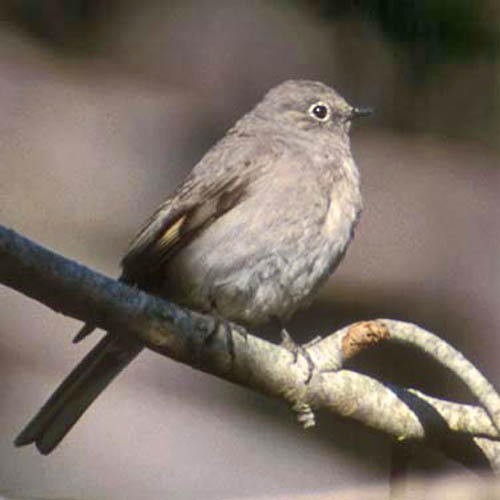
|
|
and an "almost" co-found bird
Varied Bunting
on 18 Nov 1977 at Mesquite Springs, Death Valley NP, INY
Donna
Dittmann and I were the only ones birding Mesquite Springs on this cool
November morning. We'd driven all night from Berkeley to Furnace Creek
and had spent all day on 17 Nov in search of the Streak-backed Oriole
found a week earlier. We missed it that day and again the morning of 18
Nov. We decided to check Mesquite Springs on the way back the the Bay
Area. Donna discovered the male Varied Bunting in a
huge mesquite. She called to me to come over — and I was able to take
photos (one of them here). We knew that there were a couple prior
specimens from Blythe on the State's border with Arizona from 1914, but
some considered those questionable. Donna thus wrote in her description
that this was the "first truly acceptable state record." I'm not even
the co-finder of this, but am the co-documentor. [Back in those days
there were well recognized but unwritten "rules" on what constituted
"finding" a specific bird. Such things seem less strict in today's
birding fraternity.]
We did spread word
of this great discovery from the nearest pay phone, and a fair number
of hardcore birders chased and saw it over the next 4 days. There would
not be another one in California until Oct 2012 — 35 years later. [And
as to that oriole — it took two more long-distance all-night chase
trips from the Bay Area to Furnace Creek until we refound the oriole on
11 Dec 1977.]
[photo 18 Nov 1977 © D. Roberson] |
and another not-found by me but I'm somewhere in the credits
Smith's Longspur
14 Sep 1990 at Moonglow Dairy, Moss Landing, MTY
At
the conclusion of every commercial film is a list of credits of actors,
director, producer, and a long list of those helping to make the film,
down to "best boy" and "key grip." Hold that thought.
At Moonglow Dairy, there is a dike that
separates a large freshwater pond (e.g., the run-off from dairy
operations) from tidal Elkhorn Slough — that pond is shown in the
background of this collage, and we'd be standing on the dike. On 13 Sep
1990, Doug George found an unusual longspur on this dike, on a bare
patch between the pond and the slough. Doug showed it to John Mariani,
who left a message on the BirdBox about a mystery longspur, either
Lapland or Smith's. Another call on the BirdBox said a "Vesper Sparrow"
was at the same spot. I heard these calls on the BirdBox at 9 p.m. that
night, and so I was at Moonglow early the next morning — and found the
bird! I heard its dry rattle, drew a sketch, and decided it was Smith's
Longspur — a first California record. I borrowed the phone of dairy
owners Louis & Carol Calcagno to call locals and Joe Morlan. I took
photos over two hours before others arrived. Brian Weed arrived and
eventually so did Joe, who liked it for Smith's. We got out the word
and by day's end many had seen the bird. It remained to 18 Sep.
So this is officially Doug George's find. Yet,
had I not relocated it, 'confirmed' a tentative i.d., and taken photos,
it might have remained uncertain. Who can say? Call me "best boy" but
I'm happy to be among the list of credits.
[longspur photo 14 Sep 1990 © D. Roberson, dairy photo in Nov 2008] |
|
|
|
|
 Things
are different now. With the perspective of 40 years, there are many
things I miss about those times, and one of those is just how many
birds there were around [there are also many other things I don't
miss]. Before I begin to forget, I thought it would be fun to put
together a self-ranked "top ten" set of stories and documentation of my
"personal best finds."
Things
are different now. With the perspective of 40 years, there are many
things I miss about those times, and one of those is just how many
birds there were around [there are also many other things I don't
miss]. Before I begin to forget, I thought it would be fun to put
together a self-ranked "top ten" set of stories and documentation of my
"personal best finds."  # 1
# 1  # 2
# 2

